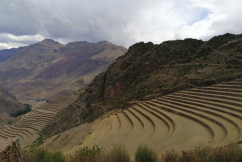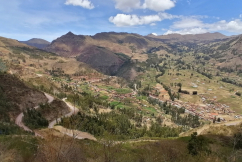Many come to Peru to re-gain “connection”. They either go to the Amazon jungle to stay with the local communities (which some call tribes), or to the Andes Mountains, mostly in the areas of Cuzco (Sp. Cusco) and Pisac (Sp. Písac), to align with the ancient Inca spirit.
I spent some time in both, Cuzco and Pisac. While Cuzco is the domain of hikers as well as spiritual travelers (moutain spirit seekers if you wish), Pisac seems to be the real hub of New Age enthusiasts who scold “The System” (world politics, taxes, institutionalizing etc.) while they often use it to support themselves on their travels and adventures. They often claim that Cuzco is touristy and inauthentic…
My Story of the Peruvian Mountains
I first came to the Sacred Valley, Pisac, in April 2019, with a Czech friend of mine. I came there after a span of time spent in the warmth and sunshine of Northern Brasil. The Andes of Peru were a shock for me with the low temperatures, no heaters and high altitudes.
I must say that the energy of Peru, generally, but especially in the mountains, was at that time just too strong for me in various respects. I have received some of the greatest lessons of my life there and probably the greatest cleansing too. In the freezing cold and frequent rain, with diarrhoea and altitude issues, I got all the way to the core of my being… I went through some serious doubts and downs when it comes to spirituality, kindness and goodness of humankind, world healing and volunteering… Yet, I knew already then I would be coming back some day. And that was meant to be July 2021, arriving to Cusco just a few weeks after its re-opening after the Covid peak.
Pisac versus Cusco – Rainbow People, Eso and New Age Enthusiasts versus Hikers and Tourists
If you come to the Andes mostly to hike up some of the renowned mountains – Machu Picchu or the Rainbow Mountain – stay in Cusco. Most agencies and colectivos would be starting from there and you can easily arrange for a hotel/hostel pick up too. Cusco is a picturesque town with some original Inca stone as well colonial architecture (the renowned balconies). You can enjoy night life here and many vegan/vegetarian cafés and great restaurants.
If you arrive as a merchant, entrepreneur and such, again, Cusco is your place, mainly the San Pedro market – not far from the main Plaza de Armas square – where you get anything from palo santo to alpaca scarfs, music instruments and even mild drugs such as rapé, mambe or san pedro powder.
Now, if you come to the mountains mostly for “spiritual growth and connection” and you want to practise yoga, go to temazcals, receive kambo and join the ayahuasca circles, you´d better stay in Pisac, situated right amidst the Sacred Valley, on the Vilcanota River, a small, calm, almost sleepy town, where the mountains are a walking distance away only (while in Cusco you usually need to take a cab to reach the hiking trails and paths).
Ask at the tourist centre (where they speak no English) in the main square, Central Plaza (where there is a nice, small market too, which grows big on Sundays as people from the surrounding communities come together to sell and buy produce, crafts and other supplies) or in the local cafés and restaurants (for some reason a Sunday meeting point for all those who come to offer spiritual work is the Sacred Sushi) for the current offer of classes or circles you could join – you can also gain some info in the local laundries (where you get a kg of your clothes washed, dried and folded for approx. 6 soles). Commonly, people join the Sacred Valley Tribe for the ayahuasca circles, but please, do not consider this an advert, I haven’t been to this particular one myself.
Pisac is also a place for all those who are coming from the jungle after ayahuasca ceremonies, diets and other “programmes” carried out amidst the local tribes. You can relax here, after the strenuous physical and mental efforts, get some good food and a “time-off” from everything and everyone, if you wish. Camping is allowed here, so you can stay anywhere in the mountains around the town in your hammock if that´s what you like, coming down to town just for some essential supplies. As it is cold here, mosquitoes are rare, which is a nice change from the permanent jungle-scratch.
Unlike in Cusco, you can find truly low-cost accommodation in Pisac, e.g. homestays for 25 soles per night (private room, shared bathroom, no heating) and you can eat at the local food market (do not confuse with the art and craft market) for 4 soles (a veggie soup or rice and veggies). You can also rent a house which would usually include electric heaters or fire places. Pisac is known for its Inca Písa and a garden or a yard where you can enjoy little ceremonies with friends, singing icaros and sacred chants under the starry sky…
The altitude of Pisac is slightly lower than that of Cusco (which reaches 3,400 m of elevation) – just 2,972 m.
Visitors to Cusco would be often wearing casual or hiking clothes while those in Pisac pride themselves in wearing colourful, rainbow-like, natural materials, local production clothing including the alpaca and lama scarfs, hats, and possibly gloves and calf slips.
The two towns are about 45-min car drive away on one road (which is sometimes closed due to stone falls), and about an hour and a half car drive on the other road.
What to do in Pisac
Pisac is known for its Inca Písac ruins, which lie atop a hill at the entrance to the valley. The ruins are separated along the ridge into four groups: P’isaqa, Inti Watana, Qalla Q’asa, and Kinchiraqay. Inti Watana group includes the Temple of the Sun, baths, altars, water fountains, and a ceremonial platform. Qalla Q’asa, which overlooks the valley, is known as the citadel.
From Pisac, you can take a taxi to Lamay from where you can walk to Huchuy Qosqo, an Incan archaeological site overlooking the Sacred Valley.
You can also make a day trip Kinsa Cocha lake. There are three in fact: Kinsa, Azul and Puma. If you do not like to go up steep hills, make a deal with your taxi driver to take you first to Kinsa (about 40 minutes from Pisac), spend some time there, and then drive about three kilometers more to Lake Azul. If you want to walk around the place and take some nice photos, you need about an hour and a half at Kinsa and then about the same time at Laguna Azul. On the spot, you will meet llamas and alpacas. Make sure the driver does not charge you more than 60 soles per person for the round trip and waiting.
Living in Pisac, you will find it easy to explore other nearby villages, such as Calca, Urubamba, or Ollantaytambo with its renowned fortress.
To learn what you can do in Cusco, see the article HERE.




















